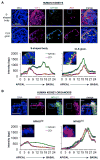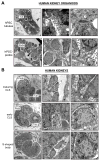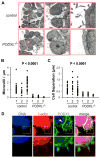Gene-Edited Human Kidney Organoids Reveal Mechanisms of Disease in Podocyte Development
- PMID: 28905451
- PMCID: PMC5742857
- DOI: 10.1002/stem.2707
Gene-Edited Human Kidney Organoids Reveal Mechanisms of Disease in Podocyte Development
Abstract
A critical event during kidney organogenesis is the differentiation of podocytes, specialized epithelial cells that filter blood plasma to form urine. Podocytes derived from human pluripotent stem cells (hPSC-podocytes) have recently been generated in nephron-like kidney organoids, but the developmental stage of these cells and their capacity to reveal disease mechanisms remains unclear. Here, we show that hPSC-podocytes phenocopy mammalian podocytes at the capillary loop stage (CLS), recapitulating key features of ultrastructure, gene expression, and mutant phenotype. hPSC-podocytes in vitro progressively establish junction-rich basal membranes (nephrin+ podocin+ ZO-1+ ) and microvillus-rich apical membranes (podocalyxin+ ), similar to CLS podocytes in vivo. Ultrastructural, biophysical, and transcriptomic analysis of podocalyxin-knockout hPSCs and derived podocytes, generated using CRISPR/Cas9, reveals defects in the assembly of microvilli and lateral spaces between developing podocytes, resulting in failed junctional migration. These defects are phenocopied in CLS glomeruli of podocalyxin-deficient mice, which cannot produce urine, thereby demonstrating that podocalyxin has a conserved and essential role in mammalian podocyte maturation. Defining the maturity of hPSC-podocytes and their capacity to reveal and recapitulate pathophysiological mechanisms establishes a powerful framework for studying human kidney disease and regeneration. Stem Cells 2017;35:2366-2378.
Keywords: Adhesion receptors; Biophysics; Cell adhesion; Developmental biology; Differentiation; Focal segmental glomerulosclerosis; Foot processes; Gene targeting; Genome editing; Kidney; Nephrin; Nephrogenesis; Pluripotent stem cells; Podocalyxin; Podocin; Slit diaphragm.
© 2017 AlphaMed Press.
Figures







References
-
- Taguchi A, Kaku Y, Ohmori T, et al. Redefining the in vivo origin of metanephric nephron progenitors enables generation of complex kidney structures from pluripotent stem cells. Cell Stem Cell. 2014;14:53–67. - PubMed
-
- Takasato M, Er PX, Chiu HS, et al. Kidney organoids from human iPS cells contain multiple lineages and model human nephrogenesis. Nature. 2015;526:564–568. - PubMed
Publication types
MeSH terms
Substances
Grants and funding
LinkOut - more resources
Full Text Sources
Other Literature Sources
Molecular Biology Databases

